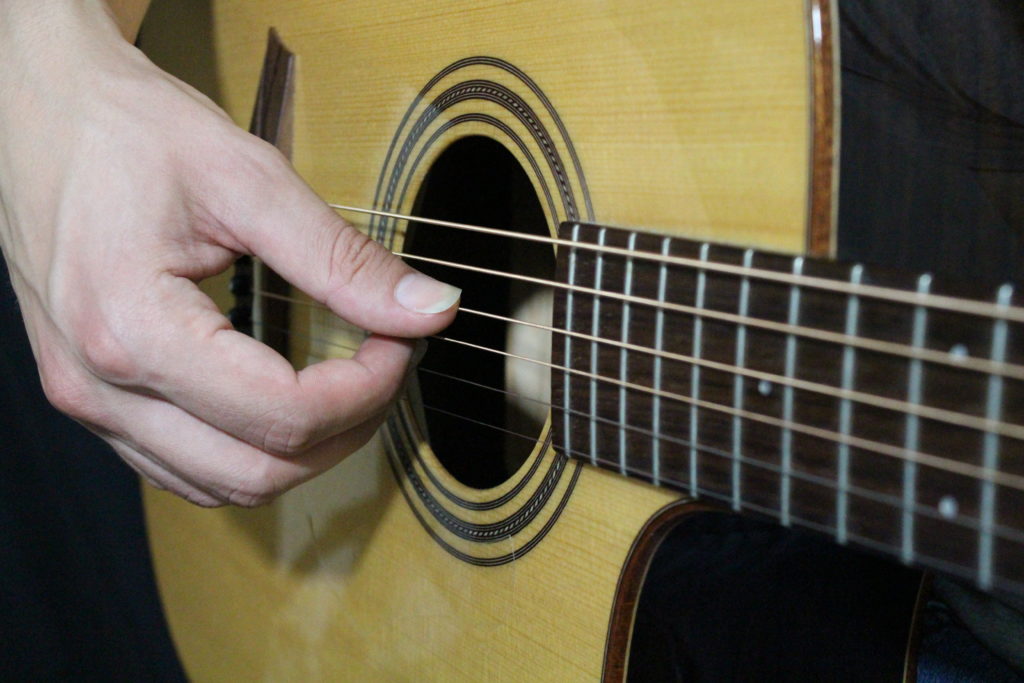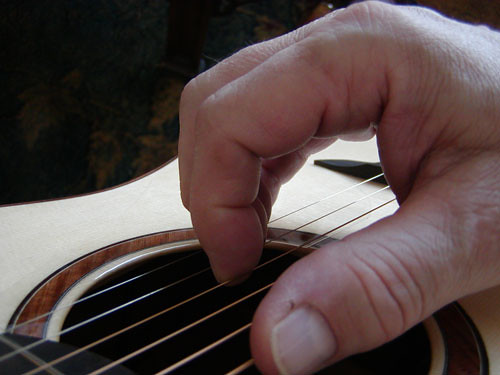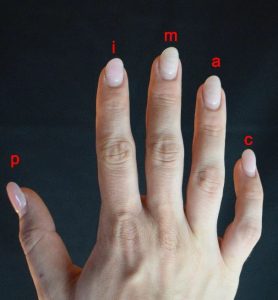One of the most common questions that arise when discussing fingerstyle is if you should use nails or flesh when playing.
Nails require you to either grow out your fingernail or apply acrylics whereas flesh doesn’t require any additional maintenance except for cutting the nails.
You may be asking, what are the main differences and advantages/disadvantages between the two?
Nails
Right off the bat, nails are going to provide a brighter tone due to the material that is striking through the string. With proper shaping and filing technique the nails could provide a warmer tone. This requires several adjustments with the filing of the nail in order for the nail to come out just right for your specific right hand technique. There are many different angles & approaches but all have the same principle.
This picture demonstrates a good nail length and shaping to start with:
Flesh
This route is the most common to start with, as it doesn’t require any additional work in order to play fingerpicking guitar. If we forget the nails and disregard any artificial product we use our flesh to fingerpick. The flesh provides a much warmer tone and less volume as well as dynamic range since it’s not likely to project as well as nails.

Here is a video on nail shaping I recommend:
Deciding on your nails or flesh is based on your personal taste and the sound that you’re trying to achieve. If you were a fingerstyle player or classical guitar player it is recommended that you at least try the nails and see if they’re a good fit for you. If you have brittle nails, there are hardening products and vitamins that can help to be able to strengthen them.
Learn more about technique through our FREE Fingerstyle Workbook!
FOLLOW US ON
Get our FREE Fingerstyle Workbook!
RELATED BLOG POSTS
Guitar Ensemble Techniques
Guitar Ensemble Techniques
Playing guitar in an ensemble setting requires a unique set of skills and techniques that differ from playing solo. When playing with others, it’s important to blend well with the rest of the instruments and create a cohesive sound. This means paying close attention to dynamics, timing, and tone, in order to complement the arrangements and melodies being played by your fellow bandmates.
One important technique to master when playing in a guitar ensemble is listening. You need to be able to listen to the other instruments in the group and adjust your playing accordingly. This includes being able to follow the rhythm set by the drummer, match the dynamics of the other instruments, and blend your tone with the rest of the group.
Another important aspect of guitar ensemble playing is communication. This includes being able to communicate with your fellow bandmates verbally and non-verbally, in order to ensure that everyone is on the same page musically. This might involve discussing song arrangements, deciding on key changes, or simply giving cues during a performance.
Overall, mastering guitar ensemble techniques can be a challenging but rewarding experience. It allows you to collaborate with other musicians, create unique and engaging music, and improve your overall musicianship. So, if you have the opportunity to play in a guitar ensemble, embrace the challenge and enjoy the journey!
Scales for Beginners
Embark on your musical journey with guitar scales for beginners at Art Guitar School, discovering the building blocks of melody and harmony.
Best Way to Learn Fingerstyle Guitar Online
Are you seeking to master the art of fingerstyle guitar playing? Whether you're a amateur or an experienced player looking to improve your talents, gaining knowledge of fingerstyle guitar online may be a handy and powerful manner to hone your approach. Here are a...






0 Comments